How to avoid the seven most common mistakes when buying a vintage slip. Insider secrets explained in this helpful guide with photo illustrations.
I have to say right from the start that if you like any vintage slip very much then you should go right ahead and buy it, irrespective of the advice given out by people like me. However, below you will find seven useful things to look out for when you are buying a vintage slip that will hopefully give you the buyer’s advantage. Even if you don’t find a slip that has all seven of these purchasing tips, just a few will put you ahead of the game and have you buying like a pro. If you are planning to purchase a vintage slip for your favourite 1940s fashion dress then following these simple and effective tips will really pay dividends and you’ll know that your slip is not only truly authentic vintage but of the highest quality too.
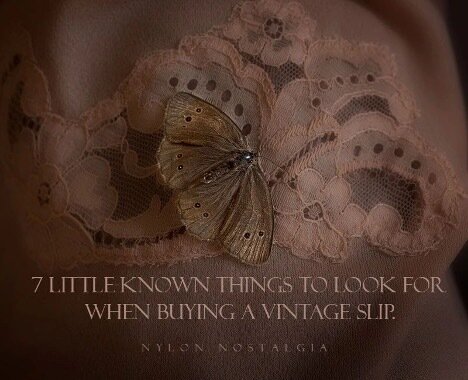
1. Make sure the lace matches on the bust.
When buying a vintage slip always make a habit of looking at the join between the two sections of lace decoration on the bust. Have the two lace sections been carefully and skillfully matched so well that the visual effect suggests it is a single, continuous piece of lace? Or, are the two sections of lace just simply joined together without any regard to the pattern, as in the photo directly below? If a slip maker cuts corners and creates defects due to sloppiness then she might be able to hide them, but there is no hiding place for badly matched lace on the bust because it will always be clearly visible.
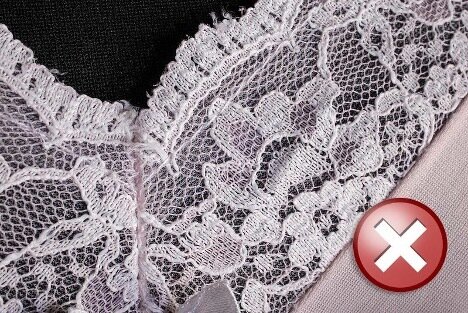
You can see here that the lace decoration on the bust has not been matched.
The slip shown in the photo above looks like the lace sections have been joined in a hurry with absolutely no regard to providing an aesthetically pleasing outcome. The end result is uneven bust lace that actually pulls the slip to one side when worn. This is a bad example, but I’ve actually seen worse. A lace join doesn’t necessarily have to be made with extreme skill like in the couture slip photo below, but when buying a vintage slip this should always be a factor to consider. Always pick a slip where the lace decoration has at least some attempt at a visually pleasing match.
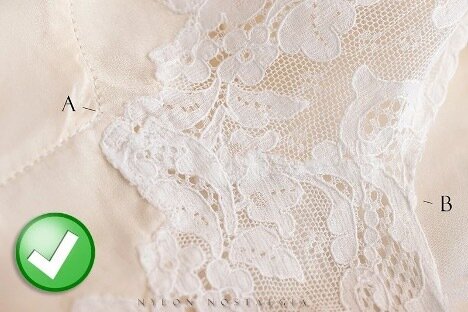
Here, two sections of lace between A & B have been joined together and matched with such skill that you can hardly tell it is a join at all.
In all garment production, time is money, and slip manufacture was no exception. There was more than one factor involved that influenced the final quality of a vintage slip and it is well worth you bearing these in mind before making a purchase. Here are just some of the reasons a vintage slip is either good or bad:
- Intent. Some slips were never intended to be anything other than low-cost mass-market items, whereas others were created to be higher quality but at a higher cost. If you’ve ever wondered why a couture slip costs hundreds of pounds to buy, it is because a highly skilled individual has created the perfect item, just for you, in an environment where speed of production is not a factor.
- Skill. Highly trained seamstresses are worth their weight in gold and are hard to find. High volume production facilities, on the other hand, struggle to retain poorly skilled staff. The end result of this is the temptation to cut corners on quality in order to fulfill orders on time.
- Time. Machinists involved in the manufacture of low cost, high volume lingerie have to turn out X number of items during their shift and in order to do so, quality control standards are often overlooked. Again, on a higher quality slip, production takes a little while longer in order to make sure features like matching joined lace sections are of an acceptable quality.
2. Appliqué or not appliqué, that is the question.
As far as garment making is concerned, by strict definition the word ‘appliqué’ just means ‘to apply a smaller piece of fabric over a larger background of fabric as an embellishment’. Those are my words but the dictionary says more or less the same. How, then, does appliqué affect your buying judgement when buying a vintage slip? Well, not all appliqué work is the same and the old rule applies very much in this case—the more work that goes into this lovely form of decoration, the finer your slip will be.
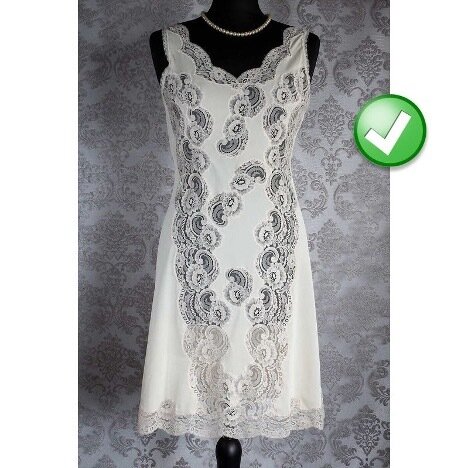
Broadly speaking, the more work that goes into a slip the higher the quality. Lots of cut-out appliqué work on this fine vintage slip.
In my view, nearly all appliqué is pretty and desirable, but the finest of all is ‘reverse appliqué’ where the background fabric is cut away from the appliqué decoration and carefully and painstakingly turned over and stitched. This is extremely time consuming and laborious but the end result is a delight to the eye.
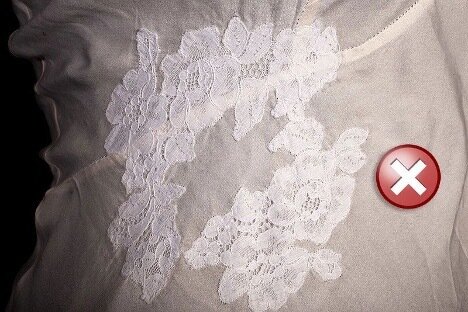
It is actually unfair of me to put a red ‘x’ on this photo of basic appliqué work because it is still hard work and quite pretty—but not as good as reverse appliqué.
3. Cut on the bias? How to spot bias-cut lingerie. Why buy bias-cut vintage slips?
Normally vintage slips have vertical seams down the body, but bias-cut slips have seams that run around the body at a 45-degree angle as that is also the direction of the fabric grain because the pattern pieces have been cut along what is known as the fabric’s true bias. True bias cut is precisely 45 degrees, not 44 degrees or 46 degrees, and this attention to detail is what sets very fine delicate lingerie apart from the rest. This is what you should be looking out for. All this might seem a little complicated and I’ll admit that a more thorough explanation of the process of making bias-cut slips and other lingerie is probably best covered by a blog post all of its own. As I said earlier in this section, you’ll notice that the seams spiral around the body at 45 degrees (although seams are also kept to a minimum on aesthetic grounds), rather than vertically as in conventional slips.
What are the benefits of wearing bias-cut slips?
- Firstly and most importantly a bias-cut slip will smoothly fit your curves to perfection in a very flattering way. You can immediately feel the difference.
- You can also see the difference because a bias-cut slip will naturally hang or drape better. The contrast with ‘ordinary’ slips is clearly visible.
- The fabric has stretch (always a good thing) and it doesn’t fray along the edges either.
- It doesn’t crease or wrinkle as much as a standard cut.
Cutting on the bias uses far more fabric than in normal lingerie manufacture, plus it requires skill— hence the higher price tag.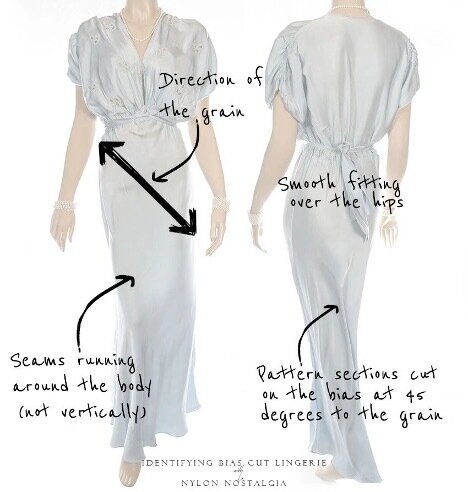
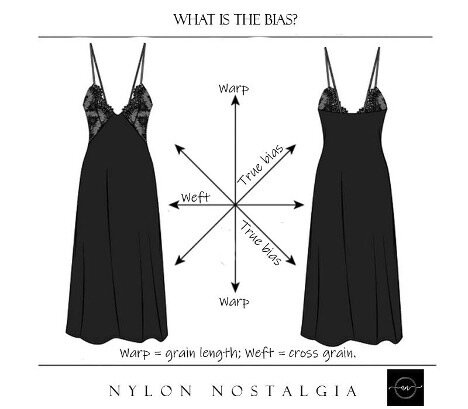
4. Gores. Gores are good.
What? Gores? What are gores? A gore is the name given to a section of fabric that that goes to make the main body of a slip. Gores are what gives shape to a slip. Generally speaking, the more gores the better—but as in other quality indicators in this article, more gores means harder work and harder work means higher cost. Gores in slips are often ‘hourglass’ shaped to bring the waist in to a taper and give a more feminine outline. Don’t get obsessed with gore counting though—four gores can make a fabulous slip. Six gores are better than four though. Eight are better still. More than eight would be too many. Just remember the humble gore when buying your vintage slip.
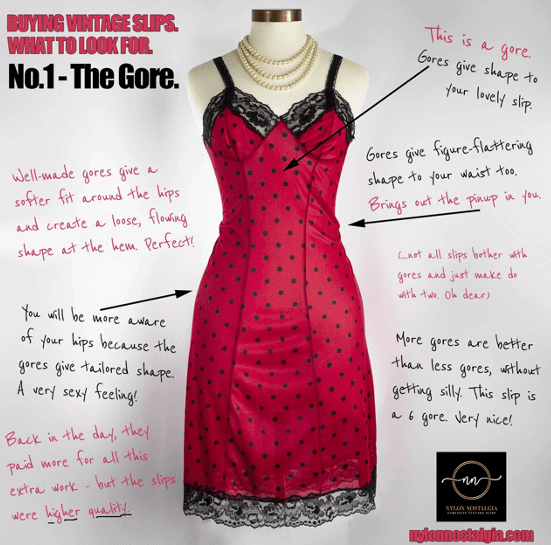
5. Pinked seams.
To the untrained eye, pinked seams can look a tad ‘amateurish’ and by that I mean not ‘neat and straight’ and ‘factory done’. Actually, nothing could be further from the truth. Cut by using pinking scissors (actually called shears), pinked seams are often described as the easiest seams to produce, which is true, but for the slip buyer it pays to look out for pinked seams for another reason—they prevent bulk on the inner side of the slip, next to your skin. This is important in lingerie as it is undesirable to constantly feel a seam against your body as you wear something.
Not that it would be you making the vintage slip of course, but it is worth knowing that during manufacture using a pair of pinking shears the cut is made into the straight grain of the fabric, meaning that each tiny little ‘V’ shaped triangle cuts into the bias. This prevents fraying of the delicate fabric that would eventually compromise the integrity of the seam, which of course is a good thing. Even better than that though, after many washes a pinked seam edge will fray a teeny-weeny bit in a non-destructive way because each ‘V’ doesn’t exactly follow the true bias (see photo below) and that will make your slip even softer to wear—far nicer than a factory-machined seam. Pinked seams are often seen in high-quality couture and high-end slips and are especially effective around the bust area.
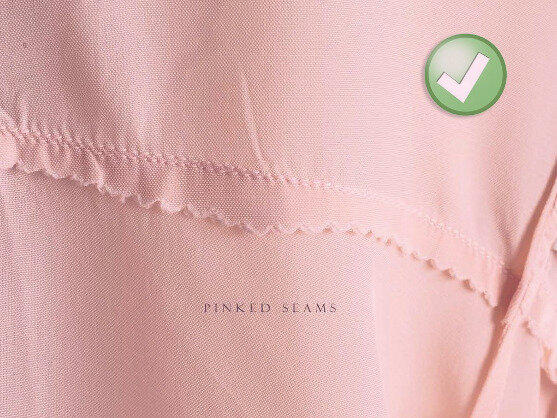
Pinked seams are a sign of quality—and you’ll feel the difference too.
6. Are the straps original?
You might think that making sure your slip’s straps are original isn’t really necessary, but you’d be surprised at just how many slips had their straps modified in some way by their owners back in the days of ‘make do and mend’. European slips often had thin ribbon straps that were not adjustable in length, so it is not uncommon to find a vintage slip where the straps have been replaced to make the slip fit bigger or smaller and rarely are they an exact match for the originals.
Be aware of these things when buying your vintage slips—have a look at the points where the straps attach to the slip. Do you see neat factory stitching, or home-spun hand stitching? The latter would be a sure sign the straps have been tampered with. Does the tone of the strap match the rest of the slip?
7. Buy the slip to suit the dress.
Not all vintage slips are alike so ask yourself the question ‘which of my favourite dresses am I most likely to wear this slip with?’ If you don’t intend to wear your newly purchased vintage slip with a dress then you can disregard all this, but if you have a particular vintage dress in mind then it pays to remember that just as dress fashions changed and evolved over the years, so did slips. Slip design trends directly responded to changing outerwear trends over the years.
For instance, let’s say you have a favourite 1940s dress and you need to buy the perfect slip to wear with it. If you liked, you could buy a 1960s fashion slip, or even one from the 1980s and wear it with the dress and to some extent they would do the job a slip was intended to do. But, if you can track down a slip that was specifically designed and made in the 1940s to wear with your dress, wouldn’t that be so much better? Of course it would. A slip shaped to match the cut and style of your favourite dress would directly influence how it feels to wear and how it outwardly looks and ‘hangs’—for the better. Don’t mismatch your slips!
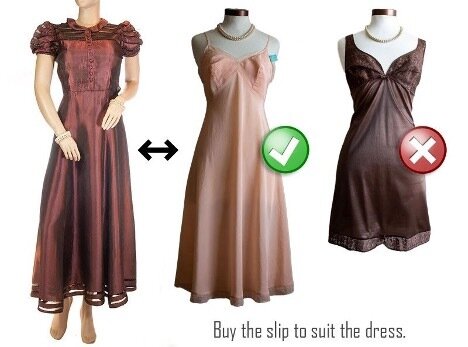
8 – Bonus section: Look at the label.
Always check the condition of the label when buying vintage underwear for women. Vintage lingerie is washed more often and more thoroughly than other items of vintage clothing such as dresses or blouses, so the condition of the label is often (but not always) a good indicator of the general state of wear of a slip. Is the label crisp and clean, or is it frayed or bleached-out? A good clean and complete label is very often a sign that the lingerie is fairly ‘new’ and has been cared for.
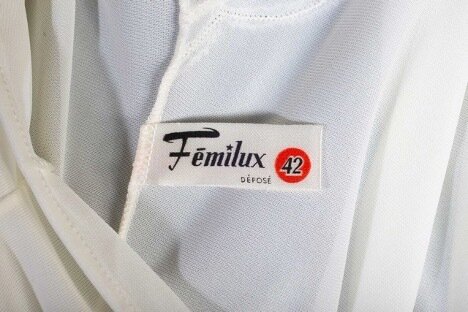
Written by Emma Benitez of Nylon Nostalgia